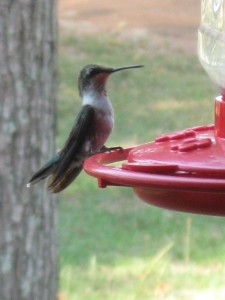Wine and Roses Weigela is known to equally attract hummingbirds and gardeners. Hummingbirds love the deep rose-colored tubular flowers, while people are attracted to the polished dark purple, almost black, foliage underneath the flowers. Wine and Roses Weigela will bloom off and on throughout the summer and quite heavily in the spring. The branches, with or without flowers, can be used in floral arrangements. Full sun will provide the best flower and foliage color. This will grow well up to USDA Zone 4 and takes medium water in a well-drained soil.
Month: April 2010

If you live in Florida, there are three species of hummingbirds that can be found there. The Ruby-throated Hummingbird is the most common hummingbird species to be found there, but in the winter you may also see the Black-chinned and Rufous Hummingbirds.
The Ruby-throated Hummingbird is extremely tiny. It measures about three inches long and weighs less then a penny or approximately 1/4 of an ounce.
The males will arrive in Florida in March and the females will generally arrive about a week after the males. The females will begin nesting in Florida in April and it is quite common for their nest to be located over water. The hummingbird’s nest is extremely tiny or only about the size of a walnut. The mother hummingbird will incubate the eggs for 20 days before the eggs hatch, after this occurs the young only remain in the nest for four weeks and then they leave the nest and are on their own.
I have been fascinated about hummingbirds for quite sometime now and have actively been writing about them for more then two years now. Much to my astonishment, even with all the information I have learned about the hummingbird within that time, my education on this subject is still always on going.
This post will share a few surprising facts or bits of trivia on the subject of hummingbirds. As I read this information, my mind turned to thoughts of my mom because she would have enjoyed hearing about it, and I thought others might as well so that is what prompted today’s post.
Here is a surprising fact about the diet of baby hummingbirds. While they remain in the nest, their diet consist of only insects which they are feed by the mother. Did you know this? I did not. This got me to thinking, “how does a young hummingbird (one that has just left the nest and is now on its own) know to add nectar as a part of its diet?” The only way I can explain this is that it is something that the young birds know instinctively.
A hummingbird’s diet is composed of both nectar and insects. The nectar provides the hummingbird the energy needed for flying and the insects are the hummingbird’s source of protein.
One more fascinating hummingbird fact to share with you. Not all species of hummingbirds migrate and of those that do not all species migrate at the same time. The Ruby-throated Hummingbird is the first to begin the migratory journey, because this species is the most sensitive to cooler temperatures.
Hummingbirds seem to move with such incredible speed. This got me to wondering just how does a hummingbird’s heart rate compare with that of a human’s? This post will offer an answer to this matter.
Just as I suspected, the heart rate of a hummingbird is indeed super fast. Just how fast may astound you. The heart rate of a hummingbird is 1,260 times per minute.
Comparatively, the human heart beats super slowly. While at rest, the normal human heart beats between 60-100 times per minute. In humans, as we age our resting heart rate will increase. Children between the ages of 6-15 years of age usually have a resting heart rate of 70-100 beats per minute. If someone is a well trained athlete, their heart rate may be as low as 40-60 beats per minute.
It is hard for me to imagine that it is possible for the hummingbird to actually survive the fact that its heart rate is so amazingly fast. It is just one of the many examples of what the hummingbird does with great speed.
